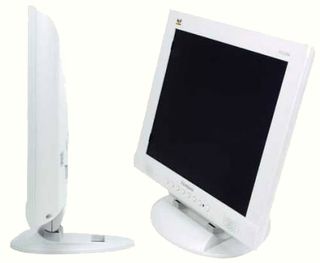17" LCD Part IV: Six Panels With 16 And 20 ms
ViewSonic VG170m

A year after they announced it at the CeBIT 2002, ViewSonic has finally released its 16-ms monitor. No surprises - it has the same AU Optronics panel as everyone else.
The ViewSonic has an original feature, however. The base folds right up against the panel. This saves pckaging space and allows you to mount it on a wall. Unfortunately, it did not occur to ViewSonic to supply a simple mounting system like the one on the ProphetView 920. Four screws and plugs are not enough: you have to buy a standard system. What a pity!
Another downside is that the VG170m is bulkier than other monitors built around an AU Optronics 16-ms panel. The housing is chunky, overlapping the panel quite a bit, and, unlike the NEC, the transformer is external.
Unlike Proview, it only has an analog interface.
The OSD menu is not so convenient, much less fun than the others. For instance, even when you set the parameters manually, you are never shown what the brightness and contrast values are. You have to do it all by guesswork. This is a pity when you think how much these two settings influence the success of calibration.
Ergonomically, the VG170m is behind the pack, and calibration does not help it catch up.
We calibrated at 75% brightness and contrast with an initial sRGB color setting (in the OSD).
Stay on the Cutting Edge
Join the experts who read Tom's Hardware for the inside track on enthusiast PC tech news — and have for over 25 years. We'll send breaking news and in-depth reviews of CPUs, GPUs, AI, maker hardware and more straight to your inbox.
The profiles can be downloaded below. Install them in C:\WINDOWS\system32\spool\drivers\color. Then, activate the one you want by going to Advanced Display Properties, then Color Management. Add the profile and select it as default.
6500 K

85% of the colors came out well (DeltaE < 2). But the 13% darkest shades are not good at all, at DeltaE > 3.
At 5000 K it's worse. Despite a great many tries with all sorts of parameters, we could never do better than 71% of colors properly displayed.
5000 K

ViewSonic applies the ISO 13406-2 standard to its monitors. They replace the 17" ones at three black or three white pixels or seven color ones. So they could do better. Add this to its rather conventional design, unoriginal ergonomics and poor color quality, and the verdict is that other monitors are a lot better.
Most Popular

